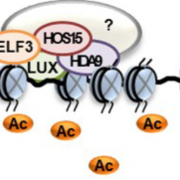
HOS15 Co-regulates Photoperiodic Flowering with the Evening Complex via Transcriptional Repression of GIGANTEA
When animals are stressed by unfavorable environmental conditions, they will typically move to a more favorable location to reduce that stress. Unfortunately for plants, they are quite literally rooted to the ground and thus must manage the stress where they stand. In order to deal with adverse environmental…
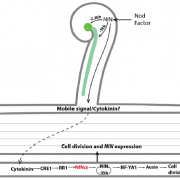
Solving a Cold Case: Identification of Promoter Elements to Complement Medicago nin Mutants
Legumes associate with beneficial soil bacteria called rhizobia to acquire plant-usable ammonia in a process called root nodule symbiosis (RNS). This association is so valuable for nitrogen starved legumes that they form specialized new organs to house them. These de novo organs, called nodules, develop…

97 Shades of Gray: Genetic interactions of the gray mold, Botrytis cinerea, with wild and domesticated tomato
Although a vineyard full of decaying grapes infected with noble rot is a blessing for sweet wine producers, the causal agent, Botrytis cinerea (gray mold), causes huge crop losses. Unlike most plant pathogens, individual isolates of the necrotrophic fungus can infect an extremely broad range of plants,…
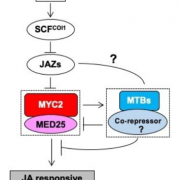
Master MYCs: MYC2, the jasmonate signaling ‘master switch’
To optimize their fitness in the field, plants need to respond rapidly, specifically and dynamically to an ever-changing and often hostile environment. By integrating external environmental cues with endogenous developmental programs, phytohormones play a critical role in the cross-talk between signal…
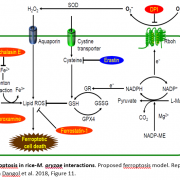
Ferroptosis: A companion of ROS in fighting Magnaporthe in rice
Invasion of plant tissues by pathogens is well known to activate localized reactive oxygen species (ROS) production and cell death. However, the sources of ROS production and their role in triggering cell death are enigmatic. A recent study by Dangol et al. (2018) shows that, in rice (Oryza sativa),…

Too Much, Take it Back: PAP Moves from the Cytosol to Plastids and Mitochondria for Degradation via PAPST2
Plants need to strike a fine balance between the production, transport, and degradation of stress signals in order to optimize growth in fluctuating environmental conditions. The signal 3’phosphoadenosine 5’phosphate (PAP) accumulates during drought and light stress and induces stress-responsive…

The AREB1-ADA2b-GCN5 Complex Regulates Gene Expression during Drought Stress
Abiotic stresses constitute a global threat to agricultural crop production and natural ecosystems. One of the most prominent abiotic stresses is drought, which dramatically alters plant physiology and morphology. Studies in model organisms have shed light into how plants respond to drought stress, including…
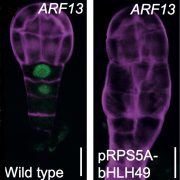
Suspended Animation: A Transcriptional Module Triggers Embryo Formation in Suspensor Cells
Of all plant behaviors, ectopic embryogenesis (reviewed in Radoeva and Weijers, 2014) might be one of the coolest. Zygotic embryogenesis begins with fertilization, followed by an asymmetric cell division that generates two cells with distinct fates. The small apical cell gives rise to the pro-embryo,…
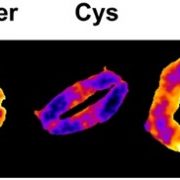
Uncovering the Steps Before: Sulfate Induces ABA Biosynthesis and Stomatal Closure
Plant stomatal aperture regulation via guard cells is an example of how plants dynamically process environmental signals to induce a physiological response. The drought stress hormone abscisic acid (ABA) is a well-characterized signal that induces stomatal closure, preventing water loss. ABA acts via…

